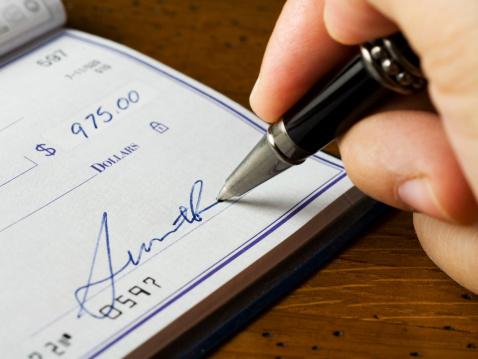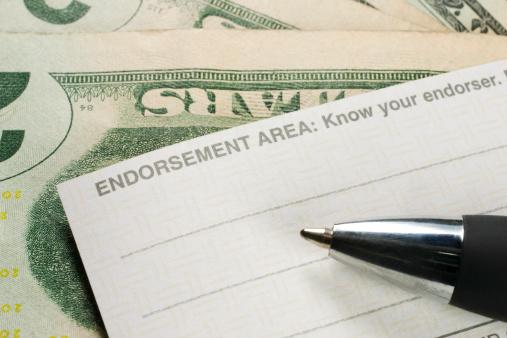What Do You Need to Know About the Back of a Check?
Jan 17, 2024 By Susan Kelly
Overview
In order to deposit a check into your account after receiving payment by check, you normally need to sign the check back. Endorsing the check means signing the reverse of it. You can endorse a check securely if you follow our advice.
What Do You Need to Know About the Back of a Check? It must first receive your support. What you write on the check and when you sign it depends on what you intend to do with it, along with how well the check is written. You can settle the sums associated with a check with your bank, a third party, and yourself by endorsing it.
Every back of a check is almost as vital to read as the front. Therefore, you should be able to. You endorsing it is an essential step in turning it into cash. Paper checks are still commonly used for significant transactions like paying rent, receiving cash, or changing your checking account, in a world where digital currencies are the norm.
Here is a guide to navigating What Do You Need to Know About the Back of a Check? After you've learned the crucial information that is printed on the front.
Steps for Signing a Check
There are various methods for endorsing checks, and which method you use will depend on what you intend to do with the cash and the way the check must be filled out. This is a crucial part of What Do You Need to Know About the Back of a Check?
- Check the check's information to make sure. It's crucial to confirm that all the data is accurate. The name on the check's payee line (which reads "Pay to the Order Of...") must match the name on the endorsement. If you receive a check and the person has misspelled your name, endorse the check's back with both spellings before signing your name there in the correct manner. The date, sum, and signature, however, shall all be correct for future reference.
- Determine who should sign the check. Search for "and" or "or" in the compensation line if a check is payable to more than one person (i.e., multiple payees). When a check is written out to "David and Sarah smith," both David and Sarah must sign it. David OR Sarah can sign the check if it is payable to "David or Sarah Smith."This frequently occurs when people include a check in a wedding card. To ensure you are properly endorsing the check, check the pay-to-line.
- On the check's back, sign or endorse it. "Endorse Here" may be written on a single line or in a box. Do not start writing, stamp, or signature below this line is typically stated on another line. The endorsement section normally extends across the width of the check and is about 1.5" long.
Who Signs the Check's Back?
About where to put signatures, there is a lot of misunderstanding. When writing a check, did you sign the reverse side, or does the recipient have to do so?
A check's front, directly on the signature line, is the one place users need to sign. When writing a check, you can, however, write instructions on the back. 'Hold for deposit till December 30, 2020,' as an illustration. The catch is that there's no way to know for sure whether someone will follow your directions.
You must sign the back of any checks you receive in order to either deposit or cash them. You might add instructions restricting how the check can be utilized along with your signature. For instance, you might write "For deposit only" and your account number on the check if you're mailing it to yourself in order to deposit it into another account. 1 So, even if the check is lost in the mail, no one else will be able to cash it.
Is a Check's Back Required to Be Signed?
If the check was written payable to you and you were the recipient rather than the writer, you may, in many instances, get away simply by depositing it without a signature. It is best to sign the cheque, though. Without a sign, the check can be returned to the issuer, costing you money and adding time to your money transfer process. Even if a check is deposited by your bank without a signature being included on the back, and you see the funds put into your account, the check might be denied within a week or two later.
You'll have a greater chance of avoiding the signature on personal checks, but don't be shocked if the bank persistently asks you for one on corporate cheques or large checks.
If you are using a smartphone to deposit a check, all the same rules apply.
While some banks encourage you to write something more about smartphone deposits on your check, some banks offer a check to indicate that you're utilizing a remote deposit service. 4 Even though you may be capable of getting away with disobeying their instructions, it's best to consult your bank. You could have to wait longer to receive your money if you don't comply with the restrictions of your specific bank.
Numbers on the Back of a Check
You are probably familiar with the routing and account numbers that are printed on the front of the check, but what about the numbers that are written on the back?
Reference numbers are frequently used to track checks and are pre-printed in the endorsement area. They are especially useful for companies who print checks using blank check stock. 5 When handling the check for redemption or deposit, banks add numbers outside of the endorsing area. These banks publish their details on the cheque before sending it to the banks that will finally release the funds.
Do I always need to sign my name on a check?
A cheque without an endorsement could be accepted by some banks. Some banks will offer this service, albeit there may be a cap on the dollar amount or a longer hold here on funds than usual.

When you deposit the check, you will have to prove your identification. Even if your bank doesn't, bear in mind as a part of What Do You Need to Know About the Back of a Check?
What does the endorsement back of check mean?
There are a few extra processes necessary when somebody pays you with such a check, but it's similar to receiving cash. You have two options when it comes to that check: cashing it at the bank that issued it (which is indicated on the front of the check) or depositing it into your accounts at your bank.

Regardless, you are giving the bank permission to cash the cheque in your name. A security measure that both confirms you are the rightful receiver of the funds and gives the bank the go-ahead to perform the transaction is approving a check by check endorsement back. This topic never skips out when asked What Do You Need to Know About the Back of a Check?
conclusion
Check endorsing is a pretty easy operation that vastly increases your financial reliability. While diverse checks call for different kinds of endorsements, the majority of them entail acknowledging the check's reverse to demonstrate how you are the rightful owner of the assets they signify. We discussed everything about the concept What Do You Need to Know About the Back of a Check? , you know how the procedure functions because having to learn how to endorse a check is a fundamental component of financial literacy.
FAQs
What does it mean to sign a check's reverse side?
Endorsing a check means signing the reverse of it. The bank can use this endorsement to confirm your identification and make sure the cheque is put into the right account. The reverse of the cheque should be signed by all parties that are named on the "payment to" section on the front.
What details ought to be spelled out on a check's back before depositing it?
Endorse the check on the box or back line when you're prepared to deposit it. To ensure that the cheque cannot be cashed by anybody else, put "For depositing only" or "For smartphone deposit" on it.
Where is the check's back stamped?
You can endorse a check using a stamp in the endorsement space rather than your signature and handwritten instructions. The stamp should have the name of your company and bank, as well as your account information and any special instructions, like "For deposit only."





